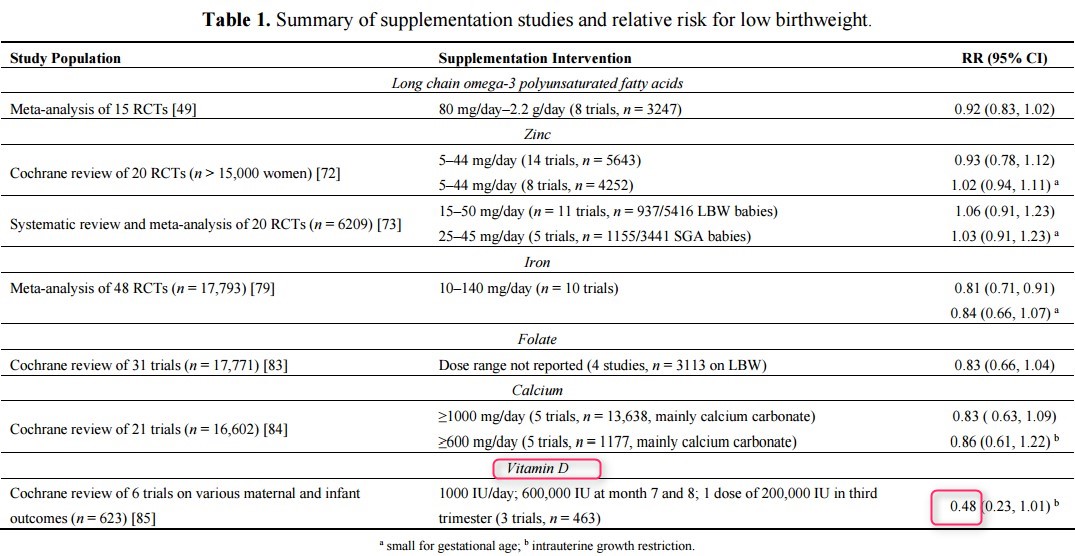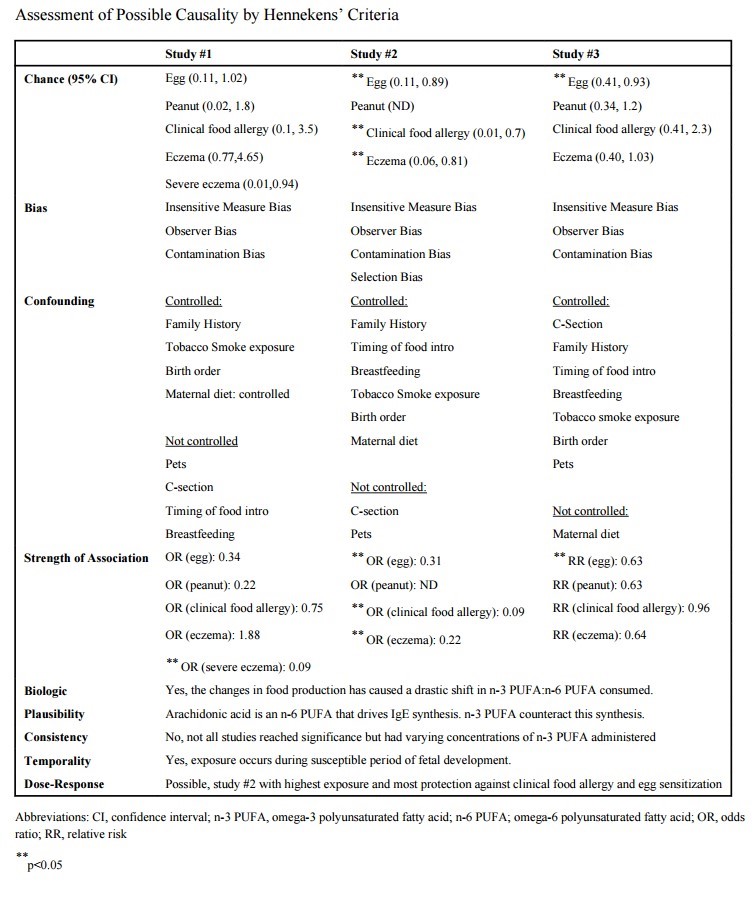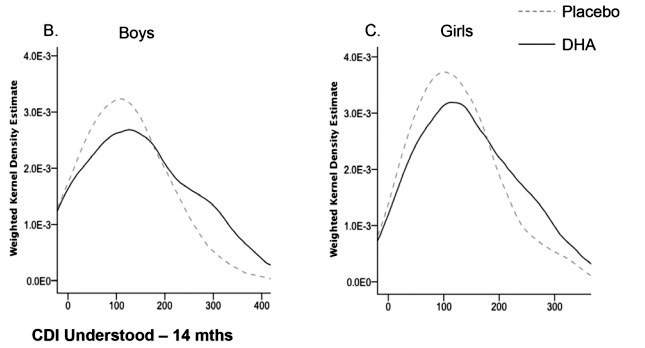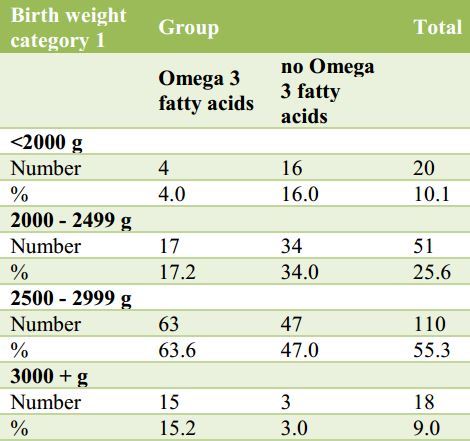Pregnancy and infants healthier with Omega-3 supplementation - many studies
VitaminDWiki pages in both of the categories Pregnancy and Omega-3
{category}
Assisted reproduction and life birth rate up by 8% for each 1% increase in Omega-3 – Nov 2017
Note: Optimal level of Omega-3 is 8%, Omega-3 going from 4% to 8% would increased AR rate by 4 X 8% = 32%
Serum omega-3 fatty acids and treatment outcomes among women undergoing assisted reproduction
Y -H Chiu A E Karmon A J Gaskins M Arvizu P L Williams I Souter B R Rueda R Hause J E Chavarro for the EARTH Study Team
Human Reproduction, https://doi.org/10.1093/humrep/dex335
Published: 10 November 2017 Article history
STUDY QUESTION: Are serum polyunsaturated fatty acids (PUFA) concentrations, including omega-3 (ω3-PUFA) and omega-6 (ω6-PUFA), related to ART outcomes?
SUMMARY ANSWER: Serum levels of long-chain ω3-PUFA were positively associated with probability of live birth among women undergoing ART.
WHAT IS KNOWN ALREADY
Intake of ω3-PUFA improves oocyte and embryo quality in animal and human studies. However, a recent cohort study found no relation between circulating ω3-PUFA levels and pregnancy rates after ART.
STUDY DESIGN SIZE, AND DURATION
This analysis included a random sample of 100 women from a prospective cohort study (EARTH) at the Massachusetts General Hospital Fertility Center who underwent 136 ART cycles within one year of blood collection.
PARTICIPANTS/MATERIALS, SETTING, METHODS
Serum fatty acids (expressed as percentage of total fatty acids) were measured by gas chromatography in samples taken between Days 3 and 9 of a stimulated cycle. Primary outcomes included the probability of implantation, clinical pregnancy and live birth per initiated cycle. Cluster-weighted generalized estimating equation (GEE) models were used to analyze the association of total and specific PUFAs with ART outcomes adjusting for age, body mass index, smoking status, physical activity, use of multivitamins and history of live birth.
MAIN RESULTS AND ROLE OF CHANCE
The median [25th, 75th percentile] serum level of ω3-PUFA was 4.7% [3.8%, 5.8%] of total fatty acids. Higher levels of serum long-chain ω3-PUFA were associated with higher probability of clinical pregnancy and live birth. Specifically, after multivariable adjustment, the probability of clinical pregnancy and live birth increased by 8% (4%, 11%) and 8% (95% CI: 1%, 16%), respectively, for every 1% increase in serum long-chain ω3-PUFA levels. Intake of long-chain ω3-PUFA was also associated with a higher probability of life birth in these women, with RR of 2.37 (95% CI: 1.02, 5.51) when replacing 1% energy of long-chain ω3-PUFA for 1% energy of saturated fatty acids. Serum ω6-PUFA, ratios of ω6 and ω3-PUFA, and total PUFA were not associated with ART outcomes.
LIMITATIONS REASONS FOR CAUTION
The generalizability of the findings to populations not undergoing infertility treatment may be limited. The use of a single measurement of serum fatty acids to characterize exposure may lead to potential misclassification during follow up.
WIDER IMPLICATIONS OF THE FINDINGS
Serum ω3-PUFA are considered biomarkers of dietary intake. The association of higher serum long chain ω3-PUFA levels with improved ART outcomes suggests that increased intake of these fats be may be beneficial for women undergoing infertility treatment with ART.
📄 Download the PDF from VitaminDWiki
Big benefits to infant if mother with Gestational Diabetes took Omega-3 for 6 weeks – March 2015
Omega-3 fatty acid supplementation affects pregnancy outcomes in gestational diabetes: a randomized, double-blind, placebo-controlled trial.
Matern Fetal Neonatal Med. 2015 Mar 9:1-7
Jamilian M1, Samimi M, Kolahdooz F, Khalaji F, Razavi M, Asemi Z.
Objective: This study was designed to assess the effects of omega-3 fatty acid supplementation on inflammatory factors, biomarkers of oxidative stress, and pregnancy outcomes among pregnant women with gestational diabetes (GDM).
Methods: This randomized, double-blind, placebo-controlled clinical trial was performed among 56 women with GDM. Subjects were randomly selected to receive either 1000 mg omega-3 fatty acid supplements (containing 180 mg eicosapentaenoic acid and 120 mg docosahexanoic acid) (n = 27) or a placebo (n = 27) for 6 weeks. Fasting blood samples were taken at study baseline and after 6 weeks of intervention to quantify biochemical variables. Newborn's weight, height, head circumference, Apgar score, and hyperbilirubinemia were determined.
Results: At the end of the 6 weeks, taking omega-3 fatty acid significantly decreased serum high-sensitivity C-reactive protein (hs-CRP) (change from baseline: -245.1 ± 1570.5 versus + 913.9 ± 2329.4 ng/mL, p = 0.03) and plasma malondialdehyde (MDA) concentrations (-0.4 ± 1.3 versus + 0.6±2.3, p = 0.04) compared with the placebo.
Supplementation with omega-3 had a low incidence of
hyperbilirubinemiain newborns (7.7% versus 33.3%, p = 0.02) and
decreased newborns' hospitalization rate (7.7% versus 33.3%, p = 0.02).
Conclusions: Taken together, omega-3 fatty acid supplementation in GDM women had beneficial effects on maternal serum hs-CRP, plasma MDA levels, incidence of newborn's hyperbilirubinemia, and h!ospitalization.
PMID: 25747955
Omega-3 reduces preterm birth by 15% and 4X less stillbirth – Meta-analysis -March 2015
perinatal death was lower 0.3% compared with 1.2% if received omega-3 before 21 weeks of gestation
Snip
TABULATION, INTEGRATION, AND RESULTS:
Nine randomized trials including 3,854 eligible women were identified. Women who received omega-3 had a similar rate of preterm birth before 37 weeks of gestation compared with women in the control group ( 7.7% compared with 9.1% , respectively; relative risk 0.90, 95% confidence interval [CI] 0.72-1.11).
There were no significant differences in birth weight, neonatal intensive care unit admission, necrotizing enterocolitis, sepsis, or perinatal death in the omega-3 compared with control groups, respectively. There were no significant differences in the subgroup analyses,
except for the rate of perinatal death, which was lower ( 0.3% compared with 1.2% ; relative risk 0.27, 95% CI 0.09-0.80) in the women who received omega-3 before 21 weeks of gestation and in trials with low risk of bias (0.3% compared with 1.0%; relative risk 0.28, 95% CI 0.09-0.89) compared with women in the control group. However, in no randomized controlled trial was perinatal death the primary outcome.
Omega-3 taken within 20 weeks of pregnancy resulted in 73% reduction in stillbirths - Sept 2015
Omega-3 long-chain polyunsaturated fatty acids and fish oil supplementation during pregnancy: which evidence?
The Journal of Maternal-Fetal & Neonatal Medicine, DOI:10.3109/14767058.2015.1086742, Published online: 18 Sep 2015
Gabriele Sacconea, Irene Sacconeb & Vincenzo Berghellac*
Objective: The aim of this study was to provide evidence-based recommendations for omega-3 supplementation during pregnancy through a systematic review of level-1 data published on this topic.
Methods: We reviewed all randomized-controlled trials (RCTs) including women who were randomized to treatment with either omega-3 supplementation or control (placebo or no treatment) during pregnancy and analyzed all the outcomes reported in the trials, separately. We planned to evaluate the effect of omega-3 on: preterm birth (PTB); pre-eclampsia (PE) and intrauterine growth restriction (IUGR); gestational diabetes; perinatal mortality; small for gestational age (SGA) and birth weight; infant eye and brain development; and postpartum depression.
Results: We identified 34 RCTs including 14 106 singletons and 2578 twins. These level-1 data showed that omega-3 was not associated with prevention of PTB, PE, IUGR, gestational diabetes, SGA, post-partum depression or better children development. Data about birth weight, perinatal mortality and childhood cognitive outcome were limited. Women with gestational diabetes who received omega-3 had significantly lower serum C-reactive protein concentrations, low incidence of hyperbilirubinemia in newborns and decreased newborns’ hospitalization rate.
Conclusions: There was not enough evidence to support the routine use of omega-3 supplementation during pregnancy. Given the 73% significant decrease in perinatal death in the singleton gestations who started omega-3 supplementation ≤ 20 weeks , further research is needed. Large RCTs in multiple gestations and longer follow-up are also required.
📄 Download the PDF from Sci-Hub via VitaminDWiki
Stillbirth rate typically 1 in 200, perhaps only 1 in 800 with Omega-3
Vitamin D and Omega-3 independantly increased infant birthweight – meta-analysis Dec 2014
A review of the impact of dietary intakes in human pregnancy on infant birthweight.
Nutrients. 2014 Dec 29;7(1):153-78. doi: 10.3390/nu7010153.
Grieger JA1, Clifton VL2.
1Robinson Research Institute, School of Paediatrics and Reproductive Health, Adelaide University, Lyell McEwin Hospital, Haydown Road, Elizabeth Vale, SA 5112, Australia. jessica.grieger@adelaide.edu.au.
2Robinson Research Institute, School of Paediatrics and Reproductive Health, Adelaide University, Lyell McEwin Hospital, Haydown Road, Elizabeth Vale, SA 5112, Australia. vicki.clifton@adelaide.edu.au.

📄 Download the PDF from VitaminDWiki
Omega-3 substantially reduced depression during pregnancy - RCT July 2014
The Effect of Omega-3 Fatty Acid Supplementation on Maternal Depression during Pregnancy: A Double Blind Randomized Controlled Clinical Trial.
Int J Community Based Nurs Midwifery. 2014 Jul;2(3):142-7.

📄 Download the PDF from VitaminDWiki
Omega-3 variation NOT associated with post-natal depression (no supplementation) - Feb 2015
Is essential fatty acid status in late pregnancy predictive of post-natal depression?
Pregnant women who ate fish 3+ times per month had less pre-term labor, less pre-eclampsia, and heavier infants - Dec 2014
The use of omega 3 on pregnancy outcomes: a single-center study.
J Pak Med Assoc. 2014 Dec;64(12):1363-5.
Fereidooni B, Jenabi E.
OBJECTIVE: To investigate the rate of Omega 3 use in pregnant women and its effect on pregnancy outcome.
METHODS: The study was conducted from January to April 2010 at Tamin Ejtemaee Hospital, Hamedan, Iran, and comprised women who were carrying 16 weeks of pregnancy and were referred to the study site. They were divided into 3 groups: those who did not consume fish in a month, those who consumed fish 1-3 times in the preceding month, and those who had it more than 3 times in the same period. Data was analysed using SPSS version 16.
RESULTS: Of the 550 subjects initially approached, 20(3.6%) either declined to participate or were lost to follow-up. The final study sample, as such, comprised 530(96.4%) who were followed up until delivery. The overall mean age of the subjects was 27.98+/-5.30 years. Of the total, 21(4%) were below 18 years, 467(88%) were between 18-35 years, and 42(8%) were over 35 years of age. Omega 3 consumption was significantly associated with neonate weight (p<0.03), pre-eclampsia (p<0.04) and pre-term labour (p<0.01).
CONCLUSION: Increased consumption of omega 3 can prevent low birth weight, pre-term labour and pre-eclampsia.
Publisher's website might have PDFor the study later after May 2015
PMID: 25842578
Omega-3 reduced early preterm delivery by 58% - meta-analysis March 2016
Effects of omega-3 fatty acids in prevention of early preterm delivery: a systematic review and meta-analysis of randomized studies.
Eur J Obstet Gynecol Reprod Biol. 2016 Mar;198:40-6. doi: 10.1016/j.ejogrb.2015.11.033. Epub 2015 Nov 30.
Kar S1, Wong M2, Rogozinska E3, Thangaratinam S4.
1 Women's Health Unit, Royal London Hospital, Bart's Health NHS Trust, London, UK. Electronic address: drsumitk33@gmail.com.
2 Department of Obstetrics & Gynaecology, Whipps Cross University Hospital, Bart's Health, London, UK.
3 Women's Health Research Unit, Barts and the London School of Medicine and Dentistry, Queen Mary University of London, London, UK.
4 Women's Health Unit, Royal London Hospital, Bart's Health NHS Trust, London, UK; Women's Health Research Unit, Barts and the London School of Medicine and Dentistry, Queen Mary University of London, London, UK; Multidisciplinary Evidence Synthesis Hub (MESH), Barts and the London School of Medicine and Dentistry, Queen Mary University of London, London, UK.
OBJECTIVE:
Preterm birth continues to be the one of the leading causes of infant deaths worldwide. There is a need for effective, easily available, safe and acceptable interventions to prevent preterm delivery, especially before 34 weeks of gestation. Omega-3 fatty acids such as EPA (eicosapentanoic acid) and DHA (docosahexanoic acid) are available as over the counter nutritional supplements, and are taken by women to improve pregnancy outcomes, without any clear recommendations. We undertook a systematic review to assess the effects of omega-3 fatty acids on early (<34 weeks) and any (<37 weeks) preterm delivery.
METHODS:
We searched MEDLINE, EMBASE and Cochrane Library from inception to 2014 without any language restrictions. Study selection, quality assessment and data extraction were done by two independent reviewers. Results were summarized as relative risks and 95% confidence intervals for dichotomous outcomes and mean differences for continuous outcomes.
RESULTS:
Of the nine included trials (5980 women), six (4193 women) evaluated the effects of omega-3 fatty acids on early preterm delivery. The risk of early preterm delivery was reduced by 58% (RR 0.42; 95% CI 0.27-0.66; I(2)=0%; p=0.0002) and any preterm delivery by 17% (RR 0.83; 95% CI 0.70-0.98; I(2)=0%; p=0.03) with the intervention. There was a significant increase in the mean gestational age by 1.95 weeks (95% CI 0.42-3.48 weeks; I(2)=0.47; p=0.01) and mean birth weight by 122.1g (95% CI 47.4-196.8; I(2)=0.84; p=0.001) in the intervention group compared to the controls. Subgroup analysis showed no significant differences in the effects between the groups according to the risk status, dose and timing of the intervention.
CONCLUSION:
Omega-3 fatty acids are effective in preventing early and any preterm delivery. The intervention is simple and easily available and has the potential to influence population based strategies in the prevention of preterm birth.
PMID: 26773247 Publisher wants $31.50 for the PDF
Omega-3 decreased preterm risk by 28% - systematic review July 2012
Effect of n-3 long-chain polyunsaturated fatty acid intake during pregnancy on maternal, infant, and child health outcomes: a systematic review.
In conclusion, n-3 LCPUFA supplementation during pregnancy resulted in a
decreased risk of early preterm delivery and a
modest increase in birthweight.
More studies in low- and middle-income countries are needed to determine any effect of n-3 LCPUFA supplementation in resource-poor settings, where n-3PUFA intake is likely low.
Random controlled intervention trials for Omega-3 during pregnancy - 49 as of Sept 2018
300 mg DHA needed during pregnancy - American Pregnancy Organization
Omega-3 Fish Oil And Pregnancy
- ISSFAL (the International Society for the Study of Fatty Acids and Lipids) has established the following recommended minimum dosage chart:
- Pregnant and Lactating Women: 300 mg DHA daily
March of Dimes agrees- Omega-3 needed especially if breastfeeding
DHAOmega institute - 300 mg is fine during pregnancy
IS TOO MUCH DHA HARMFUL DURING PREGNANCY?
women in Japan are generally well above 300 mg per day and oftentimes approach 1000 mg per day with no evidence for any harmful effects to the baby.
DHA intakes are advised before and throughout pregnancy although the last trimester is considered to be the most critical period for DHA availability during pregnancy for the baby in the womb.
For women who plan to breast feed, a continued intake of 300 mg DHA per day can be expected to provide levels of DHA in the breast milk of approximately 0.35% of total milk fat.
Babycenter says it is safe to take Omega-3 - no mercury
Is it safe to take fish oil or other omega-3 supplements during pregnancy?
Higher Omega-3 decreased child behaviour problems by 18% - March 2015
Maternal LC-PUFA status during pregnancy and child problem behavior: the Generation R Study.
Pediatr Res. 2015 Mar 12;77(3):489-97. doi: 10.1038/pr.2014.204. Epub 2014 Dec 18.
Steenweg-de Graaff JC1, Tiemeier H2, Basten MG1, Rijlaarsdam J1, Demmelmair H3, Koletzko B3, Hofman A4, Jaddoe VW5, Verhulst FC6, Roza SJ7.
BACKGROUND:
Omega 3 (n-3) and 6 (n-6) long-chain polyunsaturated fatty acids (LC-PUFAs) and the n-3:n-6 ratio are important for brain development. Whether maternal LC-PUFA status during pregnancy affects risk of problem behavior in later childhood is unclear.
METHODS:
Within a population-based cohort, we measured maternal plasma docosahexaenoic acid (DHA), eicosapentaenoic acid (EPA), and arachidonic acid (AA) concentrations and n-3:n-6-ratio in mid-pregnancy. Child emotional and behavioral problems at 6 y of age were assessed by parents (child behavior checklist), teachers (teacher report form), and combined parent/teacher report.
RESULTS:
Higher maternal DHA and n-3:n-6 ratio were associated with fewer child emotional problems using parent (odds ratio (OR)DHA = 0.82; 95% confidence interval (CI): 0.70, 0.96; P = 0.02 and ORn-3:n-6 = 0.83; 95% CI: 0.71, 0.96; P = 0.01; n = 5,307) and combined parent/teacher scores (ORDHA = 0.79; 95% CI: 0.66, 0.95; P = 0.01 and ORn-3:n-6 = 0.77; 95% CI: 0.65, 0.92; P < 0.01; n = 2,828).
Higher AA was associated with more child behavioral problems using teacher (OR = 1.10; 95% CI: 1.00, 1.20; P = 0.04; n = 3,365) and combined parent/teacher scores (OR = 1.12; 95% CI: 1.02, 1.22; P = 0.02; n = 2,827). Maternal EPA was not associated with child problem behavior.
CONCLUSION:
Indications of associations of maternal LC-PUFA status with child emotional and behavioral problems were found. Future research is needed to identify LC-PUFA-sensitive periods of fetal brain development by including multiple assessments of prenatal LC-PUFA status.
PMID: 25521921
Omega-3 supplementation for pregnant mothers decreased respiratory problems in infants by 45% - RCT Aug 2014
Omega-3 fatty acid supplementation during pregnancy and respiratory symptoms in children.
Chest. 2014 Aug;146(2):373-82. doi: 10.1378/chest.13-1432.
Escamilla-Nuñez MC, Barraza-Villarreal A, Hernández-Cadena L, Navarro-Olivos E, Sly PD, Romieu I.
BACKGROUND: Prenatal consumption of omega-3 fatty acids can act as an adjuvant in the development of the immune system and affect the inflammatory response of neonates.
METHODS: We conducted a double-blind, randomized, placebo-controlled trial in Cuernavaca, Mexico. We randomly assigned 1,094 pregnant women (18-35 years of age) to receive 400 mg/d of algal docosahexaenoic acid (DHA) or placebo from 18 to 22 weeks of gestation through delivery. Birth outcomes and respiratory symptoms information until 18 months were available for 869 mother-child pairs. Questionnaires were administered, and maternal blood samples were obtained at baseline.
Maternal atopy was based on specific IgE levels. During follow-up, information on infants' respiratory symptoms was collected through questionnaires administered at 1, 3, 6, 9, 12, and 18 months of age. Negative binomial regression models were used to evaluate the effect of supplementation on respiratory symptoms in infants.
RESULTS: Among infants of atopic mothers, a statistically significant protective effect of DHA treatment was observed on phlegm with nasal discharge or nasal congestion (0.78; 95% CI, 0.60-1.02) and fever with phlegm and nasal discharge or nasal congestion (0.53; 95% CI, 0.29-0.99), adjusting for potential confounders.
CONCLUSIONS: Our results support the hypothesis that DHA supplementation during pregnancy may decrease the incidence of respiratory symptoms in children with a history of maternal atopy.
TRIAL REGISTRY: ClinicalTrials.gov; No.: NCT00646360; ur
1. Omega-3 during pregnancy cut food allergies in half - March 2014
Effect of maternal ω3 fatty acid supplementation on infant allergy.
Ann Allergy Asthma Immunol. 2014 Mar;112(3):191-4. doi: 10.1016/j.anai.2014.01.009.
Ciaccio CE1, Girdhar M2.
1Division of Allergy/Asthma/Immunology, Children's Mercy Hospital, Kansas City, Missouri. Electronic address: ceciaccio@cmh.edu.
2Division of Allergy/Asthma/Immunology, Children's Mercy Hospital, Kansas City, Missouri.

1. Omega-3 during pregnancy improved word usage and understanding - RCT Jan 2014
Omega-3 fatty acid deficiency in infants before birth identified using a randomized trial of maternal DHA supplementation in pregnancy.
PLoS One. 2014 Jan 10;9(1):e83764. doi: 10.1371/journal.pone.0083764. eCollection 2014.
Mulder KA1, King DJ1, Innis SM1.
BACKGROUND: DHA is accumulated in the central nervous system (CNS) before birth and is involved in early developmental processes, such as neurite outgrowth and gene expression.
OBJECTIVE: To determine whether fetal DHA insufficiency occurs and constrains CNS development in term gestation infants.
DESIGN: A risk reduction model using a randomized prospective study of term gestation single birth healthy infants born to women (n = 270) given a placebo or 400 mg/day DHA from 16 wk gestation to delivery. Fetal DHA deficiency sufficient to constrain CNS development was assessed based on increased risk that infants in the placebo group would not achieve neurodevelopment scores in the top quartile of all infants in the study.
RESULTS: Infants in the placebo group were at increased risk of lower language development assessed as
words understood (OR 3.22, CL 1.49-6.94, P = 0.002) and produced (OR 2.61, CL 1.22-5.58, P = 0.01) at 14 mo** and
words understood (OR 2.77, CL 1.23-6.28, P = 0.03) and sentences produced (OR 2.60, CL 1.15-5.89, P = 0.02) at 18 mo
using the McArthur Communicative Developmental Inventory;
receptive (OR 2.23, CL 1.08-4.60, P = 0.02) and
expressive language (OR 1.89, CL 0.94-3.83, P = 0.05) at 18 mo
using the Bayley Scales of Infant Development III; and visual acuity (OR 2.69, CL 1.10-6.54, P = 0.03) at 2 mo.

TRIAL REGISTRATION: ClinicalTrials.gov NCT00620672. PMID: 24427279
1. Omega-3 increased birth weights - Dec 2017
Role of omega 3 fatty acids on pregnancy outcome
📄 Download the PDF from VitaminDWiki *
EPA 180mg, DHA 120mg once daily.
Supplementation was started at the first visit of the patient to the hospital
Results: The study showed that 78.8% patients supplemented with omega 3 fatty acids achieved neonatal birth weight more than 2.5Kg compared to 50% of patients who were not supplemented.

1. Omega-3 Fatty Acids and Maternal and Child Health: An Updated Systematic Review (not help) - 2016
AHRQ huge report
1. There have been <span style="color:#00F;"><!-- {SQL(db=>vitamind)}SELECT hits FROM tiki_pages WHERE page_id=6419{SQL} --></span> visits to this page
